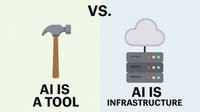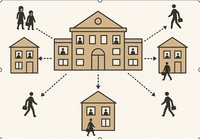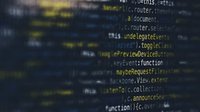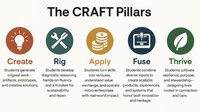Chapter 2, The Consumerization of Learning
An Epic Road Trip
Fear and Disbelief
I have been working non-stop on a nationwide tour of eighty seven cities, speaking about what is happening. Since January 2014, I have helped the education sector with strategy and tactics designed to help them survive the consumerization of learning unruffled, though changed.
Today, teachers and schools everywhere are in uncharted waters of digital learning objects constructed much like the most engaging games, ones that use increasingly sophisticated machine learning within their inner workings, sporting algorithms that are exceedingly precise at customizing the views to the learner.
I first gave a talk about “Surviving the Consumerization of Learning” to three hundred K-12 school administrators and educators at Monmouth University in New Jersey on May 20, 2016. I presented the idea that schools would eventually level up to join the rest of corporate America in the Experience Economy.
About a dozen people came up to me after I spoke and were very grateful for the insights, but a couple of them said some things that struck me as very odd. They voiced their concern that the idea of consumerization of learning “needed to be stopped,” or “That’s horrible what you talked about. What are we going to do?”
At first, I thought to myself, “Whoa, that person somehow got what I said all twisted up and backwards.” But that wasn’t it, really, because I had staff come up to me and say that they’d heard the same sort of things from various other educators who had been in attendance. “Curiouser and curiouser,” I thought, with a finger on my chin.
Then I realized I’d just presented an idea that schools are being potentially competitively overwhelmed by something outside of themselves, namely the consumers of learning and commercial markets who are bypassing schools with various digital learning objects, like apps, what is known as “courseware” or digital lesson software, eBooks, various learning games, and online courses of study, such as those found at Khan Academy, Udemy, Fuel Education, and thousands of others.
I came to understand this actually is a sort of horror to schools, and many conversations since that point have proved more and more that just mentioning this possibility is akin to asking for a fight.
While I was speaking, I had said to all those present that the reason schools don’t properly confront and shift to adopt the consumerization trend for learning is because they didn’t experience any part of it when they were in school. It’s an interesting exercise that leaders and administrators must be able to do – step into the shoes of their users, the digital natives. Personally, I think schools are not doing it at levels of appropriate response one would expect because they have been distracted, and perhaps purposefully. They are consumed with testing and standards, devices and networks, constant negative bashing from the outside – all things that distract and suppress attention on the real change of learning consumerization. It is just so surprising that few people see it when it is so plainly evident.
The world has changed. Outside the school, media is no longer a one-way “tell” directed at you without any way for you to talk back as in the days of only television and radio; today, media is online and interactive. It “responds.” The travel industry used to be made up of thousands of agencies with physical offices in cities worldwide, as were insurance agencies. Retail is being transformed significantly, with more and more closures, and millions of square feet of store space is going unleased as shopping online explodes.
What I find so interesting in my observations about the consumerization of learning is that it is an inevitability, not mere musings. Inevitable because consumer demand, industry marketing, and uninhibited access through the Internet are creating an unstoppable force. The fact is that as I write this, consumerized learning is a reality that is already here. I am imploring schools and teachers to see this train coming, to do what is in their power to shift.
The worry by some about any software learning being a dehumanizing force, lessening human interaction, is evidence that they don’t know what it is and can’t imagine how tech could help teachers and schools, because all they have ever seen is a tech incursion bringing mass confusion. In this they are entirely right. We should be ashamed of how the tech transition in the education sector has largely been mismanaged through lack of really visionary leadership from inside the tech reality. Product pushing, the non-profit arms of major corporations funding the marketing saturation of tech through seemingly innocent give-aways and thought leadership fests, and just the whole explosion of potentialities, has needed a firm hand to guide schools through.
What consumerized learning could be when it is fully matured is a direct route to quality knowledge on demand. It’s not true that it will be without all human interaction or lessen the fact that human teachers are an important part of a lot of learning. What can happen is that teachers are on-demand, as many software systems offer currently with “pop-up” interactive video chat in shopping systems, and that teacher specialists offer office hours for specific mentoring. The perpetually popular live physical classroom is also probable in that schools will be offering a surge of more social hands-on and project-based activities to further enliven learning around the now largely digital object world. It is how they will stay relevant. Sophisticated systems with complete customiza- tions for each learner will already offer intersection points for teacher decisions and assistance.
With this change comes huge opportunity for individuals in the teaching profession.
I have been driven by the fact that it is not enough to sit on the sidelines and comment like a bleacher journalist; what’s important to do for schools today is to show them what is happening and why, so they can see what would be obvious in survival tactics inside that future.
That is what this book is about – schools and teachers having enough understanding of all the dynamics in the market to survive the future.
So far, my continuum of change scratched out in 2013 (with schools starting first at writing strategies, going through several other stages, and much later arriving in the new Age of Experience, where most of corporate America and commerce is today) is proving true as to the stages in between. Let’s start first with the continuum of change we have been talking about in every city and through which we are helping school district lead- ers move stage by stage each year. After that, let’s look at the problems and solutions.
We might as well consider the truth of where good software development could take us when educators are not buffeted by the high winds of constant change and waves of niftiness coming out of the tech sector. When policy makers and leaders get down to business to take advantage of tech, to command it and not let it command them, then I can rest.
Until then, my favorite part of the entire massive journey, which definitely wasn’t sleeping overnight in Dallas Love Field due to tornadoes, was this:
I have no words to describe my soaring pride in each individual I have met and my amazement at the epic struggle of the American people to not just be better than other nations or the next state in how we help our kids learn and excel in life. No, the strivings are more touching than that by far. It is to just be perfect, without regard to any other nation, any other school, or any other teacher, really – it’s to give perfect learning for that neighborhood, at this time, and in this circumstance, or that one single student, right here, right now. Perfect.
No other word describes the totality of what is sought. It is a miracle you don’t find in other industries.
It is so wrenching to be one who sees it in every town, that look on some executive’s face as he or she asks me, “But what app can help this (fill in the blank)?” Or, “How can I get my teachers to (fill in the blank)?” Or, “We don’t know how to pay for it.” In their eyes I see the reflections of millions of children’s faces. Millions.
It breaks my heart.











